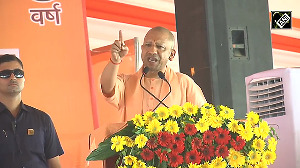'It will be best for investors to have a systematic investment plan in mid-cap and small-cap funds with a three-/five-year horizon.'

The outcome of the Jackson Hole symposium has kept global equity markets choppy the past few weeks.
Mahesh Patil, chief investment officer at Aditya Birla Sun Life Asset Management Company, in conversation with Puneet Wadhwa/Business Standard says the upside in Indian equity markets will be a function of stability in global and local macro conditions, and continued earnings delivery versus expectations.
Will every market upmove be met with resistance and selling pressure?
The recent run-up in global equities is reflected in the growing expectations of inflation peaking, commodity prices correcting, and earnings visibility.
To some extent, the bounce-back has also been driven by lower-than-expected earnings downgrade, along with steady improvement in the domestic economy.
However, the speech by the US Federal Reserve Chair Jerome Powell at Jackson Hole signals inflation in the US is still short of the Fed mark.
This is expected to exert some pressure on foreign institutional investor flows and the equity markets.
In the near term, there could be intermittent corrections.
The upside from here will be a function of stability in global and local macro conditions, and continued earnings delivery versus expectations.
How has the April-June quarter of the corporate earnings season played out?
It has been a mixed bag. While the top line has been holding up for most companies, driven by price hikes and unlocking, margin pressure has remained elevated.
The profits of Nifty50 companies came in slightly lower, owing to losses in oil and gas and marginal miss in information technology companies.
However, the domestic sectors coming off a low base aided profitability for the entire universe.
Overall, there has been a slight compression in earnings growth for 2022-2023, mainly stemming from export and commodity-linked sectors.
Do you see a reason to trim the earnings estimates for the other quarters of FY23?
Most commodities have started to ease.
Further downside risk to earnings appears limited, especially when several companies are expecting a better second half, backed by an ease in commodity prices and rebound in rural demand.
On an overall basis, we continue to have a positive outlook on the earnings trajectory.
Can developments in China puncture stability in global financial markets?
Property sector remains a main drag on the Chinese economy.
Recent data releases also reflect broad-based deceleration in the economy.
The correlation of Indian markets with Chinese equities has fallen sharply in recent months and is among the lowest compared to major global and regional markets, suggesting India's appeal as being relatively insulated from Chinese risks.
Given India's status as a major commodity importer, moderate economic slowdown in China will, in fact, be a blessing in disguise for our economy.
Is risk/reward favourable for investing in small- and mid-caps?
The Indian economy is expected to be in expansion mode over the next three-five years and will be among the best-performing economies in the world.
Since small- and mid-cap companies have greater exposure to the domestic economy than large-cap ones, they benefit more.
We remain constructive on this space over a long-term horizon.
Also, there are many companies mushrooming of late, offering opportunities to generate alpha.
From a valuation perspective, they are not cheap.
One must be mindful of stock-picking.
It will be best for investors to have a systematic investment plan in mid-cap and small-cap funds with a three-/five-year horizon.
Do you think domestic institutions that invested at lower levels will look to cash out?
Domestic institutions typically invest with a long-term horizon in mind.
Given that the Indian economy is relatively better placed versus other major regions and offers better visibility to economic and earnings growth, there is no reason for domestic institutions to cash out now.
There may be some realignment in portfolios in terms of sectors in equity schemes.
With markets trading above long-term average levels and yields on debt instruments improving concurrently, there could be some rebalancing in hybrid and asset allocation funds.
Domestic institutions have also been circumspect about the current rally and have maintained cash levels of 4-5 per cent to benefit in the event of any modest correction.
Aditya Birla Sun Life Frontline Equity Fund has not been able to generate healthy returns for its investors in the past year. Do you see the tide turning?
Given the volatility in markets over the past year, most funds in the category have underperformed the benchmark.
The fund is well-positioned to leverage from stocks catering to the domestic economy rather than global cyclicals.
It is overweight on banks (private and public sector), automotive, consumer discretionary/durables, telecommunications, and real estate.
It is underweight on oil and gas, fast-moving consumer goods, and recently reduced weighting in metal and IT.
The fund is suitable for investors looking for stability and is a disciplined approach to investing for long-term wealth creation -- preferably three-five years.












 © 2025
© 2025